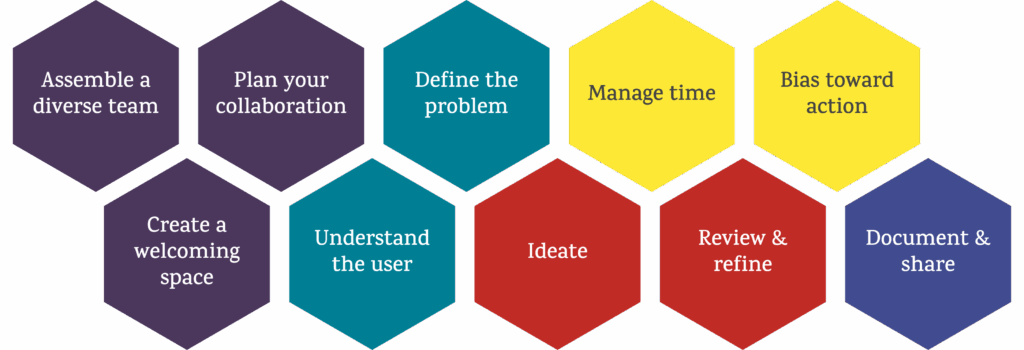Running a successful design thinking session involves fostering a collaborative and creative environment to solve complex problems. This is a guide to help you run an effective design thinking session. The process consists of many elements that aren’t necessarily linear in nature. Similar elements are grouped by color.

1. Assemble a diverse team
Bring together a cross-functional team with diverse skills, job families, and perspectives. This diversity can lead to a richer range of ideas and solutions.
More reading:
- Diversity wins: How inclusion matters, McKinsey & Company, Sundiatu Dixon-Fyle , Kevin Dolan, Dame Vivian Hunt, and Sara Prince, May 19, 2020
2. Create a welcoming space
Foster an environment where participants feel comfortable expressing their thoughts and ideas.
Start with icebreaker activities to create a positive and open atmosphere. In the session, encourage “rough draft thinking”. This helps in promoting creativity and ensures that everyone’s perspective is considered.
More reading:
- The Mistake Imperative—Why We Must Get Over Our Fear of Student Error, Youki Terada, November 19, 2020
- A Wrong Answer Is a Creative Answer, Carolyn Kaufman Psy.D., October 7, 2011
3. Plan your collaboration
“The goal of design collaboration is to get the most out of the collective skills, knowledge, various perspectives, and creativity of multiple participants to deliver the best possible work.” —Filestage
Planning is the number one priority for your design thinking session. Be well-prepared for:
- the space: virtual or in person
- the timeframe: what you can accomplish in this amount of time
- the tools: Figma, Mira, Zoom, sticky notes, whiteboards, etc.
- the team you’ve assembled and how they will contribute to your session
- and, above all, what you want to get out of the session
More reading:
- Why design collaboration is the backbone of every successful design project, Filestage, December 1, 2023
- How to Run a Meeting: 10 Meeting Facilitation Tips, Stormboard, July 6, 2023
- Meeting Facilitation Best Practices: Run Your Meetings like a Pro, Hannah Ross, Jan 14, 2022
4. Define the problem
Clearly articulate the problem or challenge that needs to be addressed. Ensure that the problem statement is broad enough to encourage creative thinking but specific enough to guide the participants.
More reading:
- What Is a Problem Statement: Definition, How-To and Examples, Jamie Bird, February 7, 2023
5. Understand the user
Empathize with the end-users. Encourage participants to put themselves in the users’ shoes and understand their needs, challenges, and desires. This step is crucial for generating solutions that genuinely address user needs.
More reading:
- Empathize, Interaction Design Foundation
- Empathetic design: the first stage of design thinking, Adam Card
6. Ideate
Encourage free-flowing idea generation without judgment. Use brainstorming techniques such as mind mapping, word association, or the “Crazy 8s” method to generate a large number of ideas.
Ideation and brainstorming methods:
- 29 brainstorming techniques: effective ways to spark creativity, Asana, October 6th, 2022
7. Review and refine
The complement to ideation is review: converge and share your ideation. Seek feedback with your team and refine your results with more ideation.
8. Manage time
Set time limits for each stage to maintain focus and momentum. Design thinking sessions should be time-boxed to prevent overthinking and encourage quick, iterative cycles.
9. Bias toward action
Design thinking is about doing, not just thinking. Encourage participants to take risks and move beyond their comfort zones. A bias towards action helps in generating tangible outcomes.
10. Document and share learnings
Keep detailed records of the design thinking session, including insights, key decisions, and feedback. Share these learnings with the team and stakeholders to ensure everyone is on the same page.
